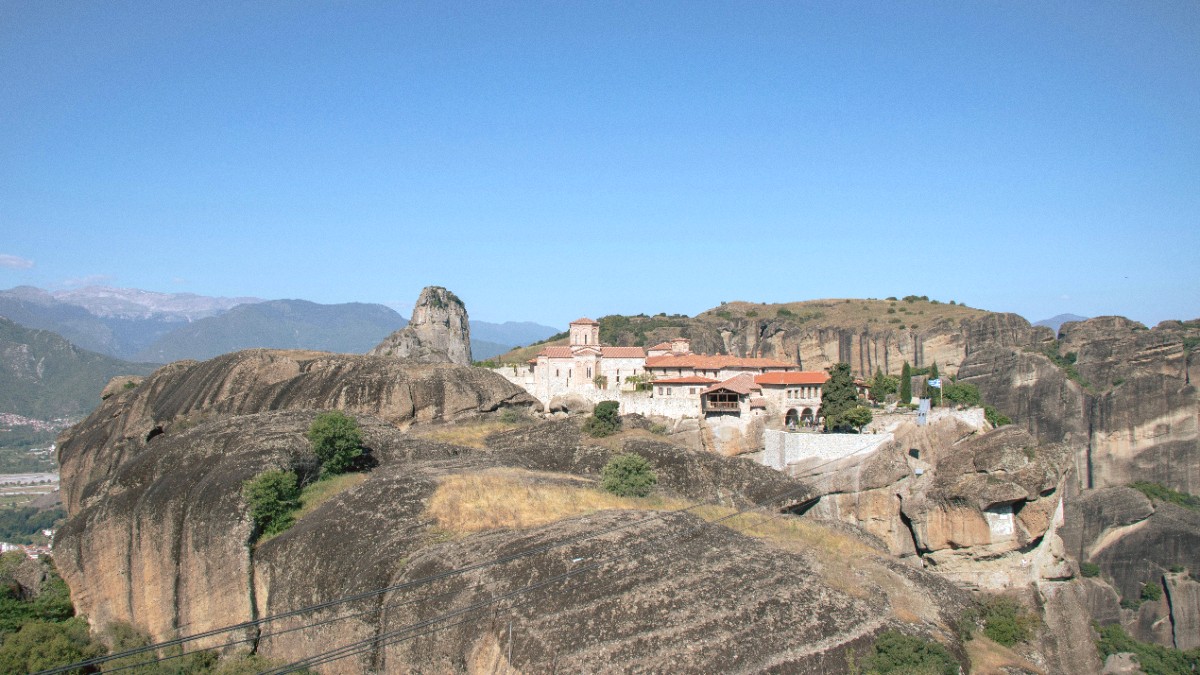
Greece
The Meteora Monasteries are the iconic landmarks of the region, perched atop imposing rock formations.
These unique geological wonders offer opportunities for photography, hiking, and simply marveling at their scale and distinct shapes.
These monasteries offer a glimpse into centuries of monastic tradition and spiritual devotion.
Arrive at opening time (usually 9:00 AM) or in the late afternoon (after 3:00 PM) to avoid peak crowds (11 AM to 3 PM).
Numerous designated viewpoints along the main monastery road offer spectacular photo opportunities at sunset. The area between Holy Trinity and St. Stephen's provides popular spots.
Consider a guided tour from GetYourGuide. Guides provide historical context and handle logistics, making the visit easier, especially if you have limited time.
St. Stephen's Monastery is the most accessible for visitors with mobility challenges due to its flat bridge access.
Wear comfortable shoes, as most monasteries involve steps or walking on uneven paths.
Beyond the monasteries, Meteora offers museums that deepen your understanding of the area's nature and history.
A unique museum in Kalambaka offering extensive collections of local birds and mammals, showing the region's biodiversity. It also features a fascinating section dedicated to mushrooms, displaying various species found in the area.
This museum in Kalambaka focuses on Greek education, traditional life, and the history of Hellenic scholars, providing insight into the broader region's cultural heritage.
This center in Kalambaka offers an immersive multimedia presentation about the geology, history, and spirituality of Meteora, serving as an excellent introduction to the site.
A small museum showing traditional tools, costumes, and everyday objects from the region's past, reflecting local customs and rural life.
Focuses on the unique geological formations of Meteora, explaining their creation and mineral composition.
Some local artists display and sell works inspired by the Meteora landscape and monastic life, providing unique souvenirs.
Explore the diverse flora and fauna of the Meteora region, with a special focus on the unique mushroom species.
Explore the history of Greek education and the traditional way of life through engaging exhibits.
Gain a comprehensive understanding of Meteora's geology, history, and spiritual significance through multimedia presentations.
The region around Meteora holds older histories beyond the monastic era.
The stunning natural landscape forms an integral part of the Meteora experience.
These geological formations offer numerous photo opportunities and chances to simply admire their grandeur.
The awe-inspiring natural rock formations themselves are the main natural attraction, providing endless opportunities for photography and wonder.
This river flows through the Thessalian plain, offering opportunities for rafting or kayaking in certain seasons, adding a dynamic water element.
The fertile plains surrounding Meteora offer scenic drives, showing Greece's agricultural heartland and diverse landscapes.
Numerous designated viewpoints along the main monastery road offer spectacular photo opportunities at sunset. Many tours conclude with a sunset stop.
Find sunset tours on GetYourGuideExplore the network of ancient footpaths connecting some of the monasteries, offering different perspectives and quieter experiences.
Discover hiking toursBeyond the famous viewpoints, seek out less crowded spots for unique angles and compositions of the rock formations.
The region is home to diverse plant life and various bird species, making it interesting for nature observers.
Away from city lights, Meteora offers clear night skies, ideal for stargazing and enjoying celestial views.
An important archaeological site near Meteora with evidence of human occupation dating from the Middle Paleolithic to the Neolithic period.
The Pineios River flows through the Thessalian plain, offering opportunities for water-based activities in certain seasons.
For optimal viewing and photography, visit the monasteries early in the morning or late in the afternoon to avoid the midday crowds and harsh light.
Consider a multi-day pass or a guided tour to maximize your time and explore into the rich history.
Venture beyond the well-trodden paths to discover Meteora's quieter, less-visited spots.
Explore the network of ancient footpaths beyond the main paved road. These trails connect some of the monasteries and offer different perspectives.
A lesser-known, non-active monastery hidden within the rock walls. This site offers a glimpse into Meteora's more secluded monastic history.
A small, traditional village located near Kalambaka. Experience local hospitality and a quieter pace, away from the main tourist hubs.
Perfect for a peaceful escape and genuine local interactions.
These ancient hermit caves are carved directly into the rock faces, offering a glimpse into the ascetic lives of early monks.
Offers a profound sense of the origins of monastic life in Meteora.
Scattered throughout the landscape are numerous smaller chapels and churches, some dating back centuries, offering quiet places for reflection.
These sites offer a cultural and spiritual connection to the region.
Offers significant archaeological findings, demonstrating ancient human occupation and some of the oldest structures.
Provides opportunities for rafting and kayaking, especially in spring, for a dynamic water experience.
Explore charming nearby villages for a taste of authentic local life and traditional Greek hospitality.